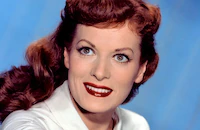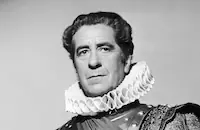Against All Flags

Brief Synopsis
Cast & Crew
George Sherman
Errol Flynn
Maureen O'hara
Anthony Quinn
Alice Kelley
Mildred Natwick
Film Details
Technical Specs

Synopsis
On board a British merchant ship in the 1700s, Lt. Brian Hawke endures twenty lashes, hoping the scars will falsely mark him as a deserter and allow him to infiltrate the pirate island of Libertania. Once on the island, he and fellow spies Jones and Harris are allowed entrance but forced to stand trial before the court of the Captains of the Coast, which is made up of the island's head pirates. At the trial, Hawke is shocked to see that a beautiful woman he flirted with earlier, Spitfire Stevens, is one of the captains. Pirate Roc Brasiliano, jealously recognizing Spitfire's attraction to the stranger, insists that Hawke prove himself in a fight to the death with a burly thief named Swaine. With Spitfire's help, Hawke wins the fight, and Brasiliano hires him as a navigator. As he outfits himself at the gunsmith's, Hawke learns that Spitfire is the daughter of the island's founding pirate, and that she protects her honor by killing any man who tries to touch her. Spitfire, who lives over the gunsmith's, calls Hawke into her chamber, where he notices a map drawn by her father showing the island fortifications. As he steals glances at the map, hoping to memorize it and provide the British with its information, Hawke charms Spitfire with lessons on how to behave like a lady. He soon joins Brasiliano on a raid of an Indian ship that is loaded with jewels. When the pirates attack, governess Molvina MacGregor disguises her lovely, sheltered charge, Princess Patma, as a harem girl and hides her below decks. As Brasiliano clears the boat and sets it on fire, MacGregor is forced to confide her secret to Hawke, and he bravely rescues Patma, who immediately falls in love with him. Back at the island, Brasiliano presents Spitfire with the finest of the raided jewels and proposes, but she turns him down and instead visits Hawke. He has just received a copy of the artillery map from his fellow spies, and rebuffs Spitfire's advances in order to put her in her place. During an auction of the harem girls, Hawke attempts to buy Patma, knowing that if the pirates learn she is the daughter of the Indian emperor, they will use her as bait against the British, but is outbid by a jealous Spitfire. Hawke then arranges with MacGregor to spirit the girl off the island that evening. Later that day, Spitfire offers Hawke her ship in return for passage to England, where she hopes to begin a civilized life. She informs him that she would like to trust him even though her father taught her never to trust a gentleman, and reveals that her real name is Prudence. Hawke admits that he loves her and asks her to trust him even when she is in doubt. He sneaks down to the beach that night with Jones and Harris to disable the island's cannons, after which they signal the British ship Man O' War, which is waiting in the bay. Hawke races to collect Patma, but is stopped by both Brasiliano, who believes he has come to steal Spitfire away, and Spitfire, who suspects he loves Patma. Patma, in a fit of pique, reveals to everyone that she is a princess just as Brasiliano finds the fortifications map in Hawke's pocket. Hawke and his men are tied to stakes in the tide pool and left to be eaten by giant crabs, but Spitfire takes pity on them at the last moment and unties them in secret. Dispirited, she accompanies Brasiliano onto his ship as he orders his guards to hold Patma prisoner at the bow. The British, realizing that if they harm Patma it will mean the death of every British citizen in India, are forced to hold their fire as the pirate sails off. Hawke, however, sneaks aboard the pirate ship just in time to save Spitfire from Brasiliano's clutches. After a close sword fight, Hawke kills Brasiliano and brings Spitfire on board the Man O'War. There, the only reward he requests is for Spitfire's life to be saved, and she kisses him gratefully.

Director
George Sherman
Cast

Errol Flynn

Maureen O'hara

Anthony Quinn
Alice Kelley

Mildred Natwick

Robert Warwick

Harry Cording
John Alderson
Phil Tully
Lester Matthews
Tudor Owen
Maurice Marsac
James Craven
James Fairfax
Michael Ross
Bill Radovich
Paul Newlan
Lewis Russell
Arthur Gould-porter
Olaf Hytten
James Logan
Keith Mcconnell
Michael Ferris
Emmett Smith
Buzz Henry
Larry Chance
Ed Hinkle
Carl Saxe
Chuck Hamilton
Mike Lally
Bruce Lansbury
Charles Fitzsimons
Renee Beard
Maralou Gray
Ethan Laidlaw
Dave Kashner
Crew
Irvin Berwick
Phil Bowles
Leslie I. Carey
Howard Christie
Oliver Emert
William Fritzsche
Russell A. Gausman
Alexander Golitzen
Frank Gross
Bernard Herzbrun
Joseph Hoffman
David S. Horsley
Percy Ikerd
Joe Lapis
Aeneas Mackenzie
Aeneas Mackenzie
Russell Metty
Hans J. Salter
John Sherwood
Douglas Sirk
Joan St. Oegger
Edward Stevenson
James Welch
Bud Westmore

Photo Collections
Film Details
Technical Specs

Articles
Against All Flags
Nonetheless, the two were finally united in this Universal loan-out directed by George Sherman and shot in glorious Technicolor by ace cinematographer Russell Metty (The Stranger [1946], Touch of Evil [1958], Imitation of Life [1959]). Set in Madagascar in the year 1700, it casts Flynn as a British naval officer going undercover to infiltrate a band of pirates led by Anthony Quinn. O'Hara plays another pirate captain, the aptly named Spitfire Stevens. The film opened in New York on Christmas Eve, 1952, and became a commercial hit. The trade paper Variety said in its review that the picture "takes a tongue-in-cheek attitude towards the plotting at times without minimizing the story's chief concerns with swashbuckling movement."
While they hadn't previously worked together, O'Hara and Flynn had known each other since the late 1930s. In her memoir, O'Hara wrote that Flynn was very professional, always knew his lines and rehearsed his fencing meticulously, but that he drank on set -- of which O'Hara greatly disapproved. "You couldn't stop him," she wrote. "Errol did whatever he liked. If the director prohibited alcohol on the set, then Errol would inject oranges with booze and eat them during breaks." His performance was best early in the day, she recalled, before he got too drunk. By 4:00 pm, he was useless. "It was very frustrating, but you forgave him because what he had given you earlier in the day had been so terrific. I performed all my romantic close-ups (shot at the end of each day) to an X marked on a black flag that was supposed to be Errol Flynn. A script girl read his lines in a dead, expressionless monotone. It was very difficult to react to her delivery and pretend the flag was Errol."
In general, however, O'Hara was very fond of Flynn, for she also wrote: "Father Time was slowly calming his wicked, wicked ways, and deep within that devilish rogue, I found a kind and fragile soul."
Director George Sherman later recalled that Flynn was skeptical about a sword fighting scene with Maureen O'Hara. "Do you think this is going to work?" Flynn asked. "You know I'm supposed to be the bravest guy on the screen. How could I fight a woman?" Sherman told him "that I had worked with O'Hara before, and that she was quite capable of holding her own with a sword, a gun, or her fists, if need be -- and I cautioned him, 'You'd better be in shape.' When we shot the scene, Maureen, of course, handled herself with the grace and ability of an experienced sword fighter. Needless to say, Flynn's attitude about fighting with a woman changed radically."
This was the second of four movies on which O'Hara would work with Sherman (following Comanche Territory [1950]). Sherman had only the most positive memories of their collaboration: "She was an ideal leading lady, blessed with talent and genuine beauty. I was lucky enough to direct her in four films, and each time she made my job as director a lot easier. She was never late, and ever prepared. Her suggestions were never intended to enhance her own role in the film, for she was sensitive to the storyline of a movie, even when it meant taking a scene away from her... Maureen O'Hara embodies professionalism."
Sherman added that O'Hara and director John Ford were so close that "whenever I'd shoot with her, he'd phone several times a week to check up on his redhead... [He] considered Maureen his favorite actress and as close to him as were his own children. She was equally devoted to him."
According to biographer David Bret, Flynn did much of his own stunt work on this picture, including a spectacular scene in which he plunges his sword into the ship's sail and rides it down to the deck, cutting the sail in half. Shot in a single take, this was a tribute to Douglas Fairbanks' The Black Pirate (1926). But ironically, Flynn later broke his ankle doing another scene -- a routine swordfight -- when he slipped on a wet surface. Production was delayed for five months.
Against All Flags was remade as the 1967 comedy The King's Pirate, starring Doug McClure and Jill St. John.
By Jeremy Arnold
SOURCES: David Bret, Errol Flynn: Satan's Angel Thomas McNulty, The Life and Career of Errol Flynn Aubrey Malone, Maureen O'Hara: The Biography Maureen O'Hara with John Nicoletti, 'Tis Herself: A Memoir Danny Peary, Close-ups

Against All Flags
Quotes
Trivia
Notes
The film opens with the following written statement: "In 1700 A.D. the Pirate Republic of Libertania on the Island of Madagascar was a constant menace to the rich trade routes to India. Several days' sail from this Pirate fortress is the British Merchant ship 'Monsoon.'" An August 1951 Hollywood Reporter news item notes that Universal held the film's script for two years before putting it into production. According to a July 1950 Variety news item, producer Jack Gross was originally assigned to the film. Hollywood Reporter news items state that Errol Flynn broke his leg while shooting a fight scene and returned to the set in a special cast which allowed him to walk and be photographed above the waist. Another Hollywood Reporter news item noted that Douglas Sirk directed two days of additional swordplay scenes on the film, as George Sherman had started shooting his next picture, Back at the Front, in Tokyo.

Miscellaneous Notes
Released in United States 1952
Released in United States on Video May 5, 1988
Released in United States 1952
Released in United States on Video May 5, 1988














